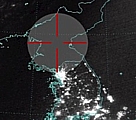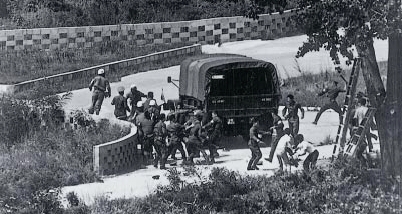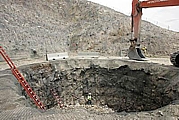Reaffirming the Nuclear Umbrella: Nuclear Policy on Autopilot
 In condemning the North Korean nuclear test and repeating its call for a denuclearized Korean Peninsula, one of the Bush administration’s first acts ironically has been to reaffirm the importance of nuclear weapons in the region.
In condemning the North Korean nuclear test and repeating its call for a denuclearized Korean Peninsula, one of the Bush administration’s first acts ironically has been to reaffirm the importance of nuclear weapons in the region.
“The United States will meet the full range of our deterrent and security commitments,” President Bush told Japan and South Korea after last week’s test. On Wednesday, Secretary of State Condoleezza Rice strongly hinted that the commitments potentially include nuclear strikes against North Korea.
But is it helpful or counterproductive at this stage to threaten North Korea with nuclear weapons?
(more…)
US Says North Korean Test Was Nuclear
In an extraordinarily brief statement, the Director of the National Intelligence Office announced that the United States has confirmed that North Korea’s large explosion last week was nuclear. How do they know and why did it take them so long to confirm?
(more…)
North Korea’s Bomb: A technical assessment [edited 16 October]
Last Sunday, North Korea apparently tested a nuclear explosive. The “apparently” is needed because the explosion was so small—by nuclear standards—that some have speculated that it may have been a large conventional explosion. What is the technical significance of the test, what does it mean, and what should we do now?
There is no question that the political and security implications of the test are huge and almost entirely negative. The technical implications are more mixed; the technical significance of the test is somewhat less than meets the eye.
(more…)
Article: Nuclear Threats Then And Now

A decision to trim a tree in the Korean demilitarized zone in 1976 escalated into a threat to use nuclear weapons. After a fatal skirmish between U.S. and North Korean border guards, U.S. forces in the region were placed on heightened alert (DEFCON 3) and nuclear forces were deployed to signal preparations for an attack on North Korea. The North Koreans did not interfere with the tree trimming again, so the threat must have worked, the Pentagon concluded.
Thirty years later, North Korea has probably developed nuclear weapons and is trying to develop long-range ballistic missiles to threaten you-know-who, and the United States has ventured into a multi-billion dollar effort to build a missile defense system and a “New Triad” to better dissuade, deter, and defeat North Korea and other “rogue” states.
So, did the threat work?
The “tree-trimming incident,” as the U.S.-North Korean scuffle has come to be known, and other examples of using nuclear threats are described in the article “Nuclear Threats Then And Now” in the Bulletin of the Atomic Scientists.
China Test-Launches New Ballistic Missile

China has test launched a DF-31 long-range ballistic missile, according to a report by the Russian news agency ITAR-TASS. The missile was said to have been launched from the Wuzhai launch site on Monday night.
The DF-31 has been under development since the 1980s and Monday’s flight test appears to be the sixth flight test of the missile since 1999. The U.S. Department of Defense predicted in 2002 that the DF-31 would be deployed “before mid-decade,” but that didn’t happen. The current DOD prediction is that deployment may happen this year. Some web sites erroneously say the missile is already operational.
The DF-31 forms the core of China’s current modernization of long-range nuclear ballistic missiles. Two modifications of the DF-31 are under development. The road-mobile DF-31A has a longer range (possibly up to 12,000 km), and the 8,000+ km range Julang-2 is intended to arm China’s next generation of ballistic missile submarines (Jin-class).
There is considerable confusion and uncertainty about the capability of the DF-31. Early reports predicted a range of at least 8,000 km (4,875 miles), but the latest DOD estimate is 7,250+ km (4,500+ miles). China has not yet tested the DF-31 to the full range reported by the DOD. Tuesday’s test launch impacted in the Takla Makan Desert some 2,500 km west of Wuzhai. If the range is 7,250+, the DF-31 will not be able to target the entire continental United States, only the most northwestern parts. Its main role may be against Russia, India, as well as U.S. facilities in the Pacific including Hawaii and Guam.
Another confusion concerns the payload. Despite widespread speculation among private analysts and media that the new missiles will carry multiple warheads, the U.S. intelligence community anticipates that all three missile types will carry a single warhead each.
Later this month (September), FAS and the Natural Resources Defense Council will publish a joint report about Chinese nuclear forces and U.S. nuclear targeting of China. The report uses high-resolution satellite images and declassified documents to describe the nuclear relationship between China and the United States.
See also: Elusive Chinese Submarine Cave Spotted | Nuclear Notebook on Chinese Nuclear Forces
Perspective on the Debate on the US-India Nuclear Deal.
Last week the House of Representatives debated and passed the United States and India Nuclear Cooperation Promotion Act of 2006. I think that most of the debate missed what I consider the most important points.
First of all, I should emphasize that every Congressman, even those most strongly opposed to the deal, introduced their remarks with praise for India. I have not yet come across any American commentator anywhere who does not feel that it is natural and desirable for the United States and India to have closer ties. I think that one of the great tragedies of the Cold War was that the United States and India seemed early on to have got their wires crossed because of misjudgments on both sides. The one issue on which everyone seems to agree is that India and the United States should be friends. Some of the Congressional comments in fact went a bit overboard. Congressman Davis of Illinois said, “India is a flourishing democracy that seeks to develop its nuclear program for purely peaceful reasons,” which is, of course, patently false—the purely peaceful part—but never mind, it fit the tone of the debate.
(more…)
Divine Strake Explosion Delayed Again, Possibly Moved
 Update (February 22, 2007): DTRA announces that Divine Strake has been canceled.
Update (February 22, 2007): DTRA announces that Divine Strake has been canceled.
The controversial Divine Strake explosion has been delayed again, this time “at least several months into calendar year 2007,” according to a statement distributed in Congress by the Defense Threat Reduction Agency. “We have stood down the experiment site and the workforce that was preparing the site for the experiment,” DTRA said.
The delay comes after DTRA told Senator Orrin Hatch (UT) that it will “look into the possibility of other locations” for conducting the Divine Strake test.
Divine Strake was initially scheduled to take place on June 2, 2006, but disclosure that the experiment was in fact intended to calibrate the use of low-yield nuclear weapons against underground targets, combined with lawsuits from local communities, caused the government to withdraw its “no impact” environmental assessment shortly before the scheduled test and delay it until September 2006.
Although DTRA has repeatedly stated that the experiment did not pose an environmental hazard, the agency now says that it is “developing a plan that would permit the conduct of the DIVINE STRAKE experiment if it is determined that the experiment can be conducted safely, is in compliance with NEPA, and there is a favorable court ruling.”
The decision to possibly move the test to another location is especially interesting because the current site was “carefully chosen” so that it “simulates the characteristics of important potential, global adversaries,” according to the DOE’s environmental assessment: “As a number of potential adversarial military targets are based in similar limestones, [Divine Strake] needed to be sited in a similar geological setting to actual military targets.” Previous high-explosive tests have been conducted at the White Sands Missile Range in New Mexico and at Misers Bluff at Planet Ranch in Arizona. We’ll see what Senator Pete Domenici from New Mexico and Jon Kyl from Arizona say about that.
The DTRA statement is not available on the web sites of DTRA, NNSA, or the Nevada Test Site. A search for Divine Strake on DTRA’s site gave “no results.” An on-line Divine Strake briefing previously posted on the DTRA web site has also been removed.
House Overwhelmingly Approves Path to Nuclear Cooperation with India.
On Wednesday, the House of Representatives passed overwhelming, 359 to 68, a bill that sets out procedures for nuclear trade with India (the link includes the House floor debate and the text of the bill, about a third of way down). It is an entirely different bill than that proposed by the White House. The White House’s suggested bill was an insult to Congress, essentially asking Congress to cede any review rights and to approve details of the nuclear deal that haven’t even been decided yet. Whatever members of Congress thought about the India-US nuclear deal, they were not going to just leave the rubber stamp on the White House steps. The House bill, H.R. 5682, clearly rebukes the President on his request for pre-approval. The ultimate details of any agreement will have to go back to Congress for approval by joint resolution.
(more…)
Article: US National Security and Preemption
 The French magazine Défense Nationale asked me to submit an article about the new U.S. National Military Strategy published by the Bush administration in March 2006 and how it relates to the so-called preemption doctrine announced by the administration in 2002. The article is included in the July 2006 issue which focuses on the nuclear deterrence debate following the announcement by French president Jacques Chiraq in January that France has adjusted its nuclear posture to target regional adversaries armed with weapons of mass destruction. The magazine is published by the Committee for National Defence Studies, an independent research institution which includes several retired generals and admirals from the French military.
The French magazine Défense Nationale asked me to submit an article about the new U.S. National Military Strategy published by the Bush administration in March 2006 and how it relates to the so-called preemption doctrine announced by the administration in 2002. The article is included in the July 2006 issue which focuses on the nuclear deterrence debate following the announcement by French president Jacques Chiraq in January that France has adjusted its nuclear posture to target regional adversaries armed with weapons of mass destruction. The magazine is published by the Committee for National Defence Studies, an independent research institution which includes several retired generals and admirals from the French military.
Pentagon Doubles Plan For New Warheads
 The Pentagon is considering acquiring up to four types of Reliable Replacement Warheads (RRW), twice as many as reported so far, according to an overview discovered by the Federation of the American Scientists on a Pentagon web site.
The Pentagon is considering acquiring up to four types of Reliable Replacement Warheads (RRW), twice as many as reported so far, according to an overview discovered by the Federation of the American Scientists on a Pentagon web site.
The Department of Energy told Congress in April that Los Alamos National Laboratory and Lawrence Livermore National Laboratory were working on “an RRW design” for completion later in 2006. The Washington Post added last month that a Senate subcommittee had added $10 million to next year’s budget to fund a design of a second RRW.
According to the new DOD overview, which looks beyond 2030, the future nuclear weapons stockpile would be made up of 4-6 different types of warheads (down from nine types today). A decision would be made mid-next decade about whether to have a mix of RRWs and existing warhead types or transition to an all RRW-stockpile.
In an apparent response to the Bush administration’s decision to reduce reliance of reserve warheads and instead transition to a “responsive infrastructure” that will produce warheads when needed, the DOD plan envisions “steady-state production of warheads for deployment” in the long term.
The plan also forecasts decisions on developments of warheads for the next generation of nuclear weapon delivery systems (missiles and aircraft).
The U.S. nuclear stockpile currently contains approximately 10,000 nuclear warheads of nine principle designs: B61, W62, W76, W78, W80, B83, W84, W87 and W88. The Bush administration has decided to reduce the total stockpile “almost in half” which is estimated to leave a stockpile of some 6,000 warheads in 2012.
Legislative Update on Indian-US Nuclear Deal
There have been some legislative developments on the India-US nuclear deal. The results are not what I would like to have seen but I suppose it could have been worse. On 27 June, the House International Relations Committee approved their version of the bill 37 to 5. On 29 June the Senate Foreign Relations Committee voted 16 to 2 in favor of their bill. Both bills give the administration and the Indians essentially everything they asked for except preapproval.
(more…)
British Parliament Report Criticizes Government Refusal to Participate in Nuclear Deterrent Inquiry
 Although the British government has promised a full and open public debate about the future of Britain’s nuclear deterrent, it has so far failed to explain what decisions need to be made, failed to provide a timetable for those decisions, and has refused to participate in a House of Commons Defence Committee inquiry on the future of Britain’s nuclear deterrent, according to a British parliamentary report. The report partially relies on research conducted by the FAS Nuclear Information Project for the SIPRI Yearbook.
Although the British government has promised a full and open public debate about the future of Britain’s nuclear deterrent, it has so far failed to explain what decisions need to be made, failed to provide a timetable for those decisions, and has refused to participate in a House of Commons Defence Committee inquiry on the future of Britain’s nuclear deterrent, according to a British parliamentary report. The report partially relies on research conducted by the FAS Nuclear Information Project for the SIPRI Yearbook.